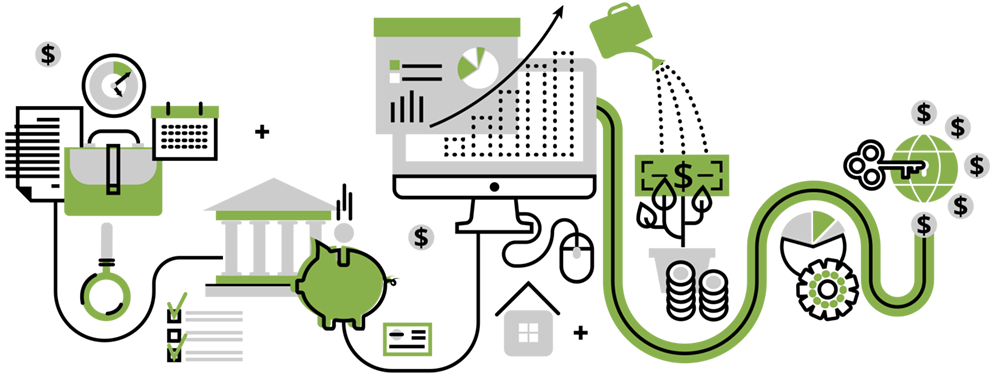With sustainability and ESG being two of the hottest topics in the world, it’s time for companies to start looking at implementing sustainability-friendly policies and processes – or risk falling behind. We delve into just how realistic a sustainable treasury is, the challenges that come with it, and the benefits that an organisation could gain from having one.

Treasurers are finding that their role in their organisation’s ESG strategy is increasing, and in turn, so is their focus on sustainability. A sustainable treasury doesn’t simply mean cutting out paper-based processes – though that can certainly be part of it. Instead, through the likes of sustainability-linked loans and thematic bonds (green bonds, gender bonds, water bonds, for example), treasurers are able to help steer their organisations towards a more sustainable future through one of their core functions: finance.
It’s not just green bonds
As of June 2019, according to Bloomberg, green finance is worth over US$31trn – and showing no signs of slowing down. Looking at that figure more holistically, it may seem small. Indeed, uptake of green finance options has been slower than some experts are happy with. According to data released in October 2019 by the World Resources Institute, just 25 of the world’s largest 50 banks have made public sustainable finance commitments.
The same report found that even among the banks with active commitments, “the average annual level of fossil fuel finance from 2016-2018 is nearly twice the annualised amount of sustainable finance commitments. Only seven banks have annualised sustainable finance targets greater than the amount of finance they provide for fossil fuel-related transactions each year.”
From this data alone, it’s clear that businesses must do more to initiate sustainable financing themselves, but many aren’t aware of all the available options. Treasurers often hear primarily about green bonds or linked loans, but as has been previously noted, the demand for green bonds unfortunately far exceeds the supply.
For Leonie Schreve, Global Head of Sustainable Finance at ING Bank, the answer may instead lie in green loans and sustainability-linked bonds. “Green loans are very closely related to green bonds, and a sustainability-linked bond is a copy of the sustainability-linked loan, where you actively support clients in their sustainable transition,” she says.
Heather Lang, Executive Director, Sustainable Finance at Sustainalytics agrees. “Green bonds and linked loans are the two major pillars, but we’ve seen a fair bit of diversity within those pillars,” she says. “We also expect to see transition financing (transition bonds) becoming a hot topic in 2020, expanding beyond projects that would already be considered green by definition to include assets and industries that are looking to transition to a low carbon economy. This will promote entry for a lot of different industry players that haven’t been part of the green bond market in the past.”
Schreve adds that a new product was launched by ING last year: the sustainability-linked derivative. She explains that this is the same concept as a sustainability-linked loan, but also enables treasurers to fully integrate their sustainability target into all their financing streams – not only in the loans but also in the derivative.
There is also more diversification in loans, explains Lang. “You have green use of proceeds loans, where the loan would finance projects or assets defined as ‘green’ or ‘sustainable’.” There are also general-purpose loans, which could be syndicated loans or revolving credit facilities, that would link the interest rates of loans to sustainability performance targets.
Going green by going paperless
Having a sustainable treasury doesn’t have to be limited to just finance though. Digitalisation, for example, can help a company go paperless and thus improve its sustainability agenda. The blockchain space is one that is rapidly expanding and has the potential to revolutionise trade documentation.
Blockchain providers don’t just hope to make trade easier, by digitalising unwieldy bills of lading and letters of credit, but in making everything paperless, the industry could save US$400-600bn per year, according to Bain & Company. Shipping giant Maersk took part in a proof of concept in 2016, exploring the use of blockchain to digitalise traditional bills of lading. It found that a simple shipment of roses from Kenya to Rotterdam generated a paper pile that measured 25cm high. Meanwhile, the International Chamber of Commerce (ICC) estimates that trade generates around four billion pages of paper documents per year.
Green bonds and linked loans are the two major pillars, but we’ve seen a fair bit of diversity within those pillars.
Heather Lang, Executive Director, Sustainable Finance, Sustainalytics
Running a quick search online for the benefits of going paperless returns millions of results on why a business should convert. In addition to cutting out stacks of paper, it’s estimated that one printer ink cartridge is thrown out every second. By going paperless, or at least reducing paper-based processes, a company would reduce its contribution to this figure, and by extension its contribution to the tonnes of oil and harmful chemicals used in production of ink cartridges.
It’s easier than you’d think
For Lang, key success factors when going green are working with sustainability teams and CSR teams internally. Historically, treasurers and CFOs haven’t worked as closely with those teams in many companies, and it’s a trend that she’s seen pick up in the last few years.
Along with collaborating internally, she adds, it is also beneficial to work with financial institutions that have their own sustainable-finance teams. “Working with underwriters that have expertise in green bonds and sustainable bonds, working with lenders who have experience with target setting around sustainability performance targets for loans is key to success,” she says.
Likewise, Schreve explains that prior to the introduction of transition finance, working towards a sustainable treasury was more challenging. “Products like green bonds and green loans are specifically tied to a defined use of proceeds. If you want to go to the green bond market, first of all you need to be an issuer, and secondly you need to have a sufficient volume of green assets in your company.”
Now though, having transition and sustainability-linked products which instead support you in identifying clear targets for the transition, the market is immediately opened up to a much broader spectrum of clients in a wider variety of sectors. “By opening up the markets from outside just the regular ‘green sectors’, there is a lot of opportunity for others to also build sustainable treasuries,” she says.
What are transition bonds?
According to the Institute of Sustainable Finance, “transition bonds are a new class of bonds, the proceeds of which are used to fund a firm’s transition towards a reduced environmental impact or to reduce its carbon emissions. The proceeds can be used exclusively to finance new and/or existing eligible transition projects. These bonds require the issuer to commit to shifting to more sustainable business practices. Transition bonds do not require the project or the issuer to be classified as ‘green’, but the issuer is required to use the proceeds for climate transition-related activities.
“For example, a coal-mining firm may issue a transition bond to finance efforts to capture and store carbon. Advocates of transition bonds suggest that it is better for companies aspiring to become ‘greener’ to finance their assets using transition bonds rather than be excluded from the green bond market without an alternative source of funding to support transition projects.”

It pays to be green
A primary benefit of following sustainable finance routes, according to Lang, is accessing the capital and diversifying the base of investors and lenders. Linked to that is being able to showcase this to different stakeholders and really improve the external profile for the sustainability commitments that are being made. Showcasing to direct stakeholders isn’t all that matters though, as the public reputation of a company can also be boosted by having a sustainable agenda.
Schreve believes that this doesn’t just come from consumers, but also from potential employees. “I see all young employees and part of their decision to join ING is that they see we play a leading role on the sustainability front, and that is very important to them. With a scarcity of resources, this is a differentiator which can really help attract talent,” she says.
Of course, the rate of return on sustainable investments should also be a key driver. A 2019 study by Morningstar found that more than 34% of sustainable European funds appeared in the top quartile of their category and 63% were in the top half. Meanwhile, according to Bloomberg, nine of the biggest ESG mutual funds in the US outperformed the Standard & Poor’s 500 Index in 2019, and seven of them beat their market benchmarks over the past five years.
From these results – and many others that have been published – it’s clear that ESG and sustainable investments do indeed pay. This success is showing no signs of slowing down, either. Lang points out that the most recent figures from the Global Sustainable Investment Alliance for the two-year period from 2016-2018 indicate that by the end of 2018 over US$30trn assets under management had been invested through some form of responsible or sustainable investing. “That was a 50% growth rate over just a two-year period,” she says.
There are also the long-term benefits to think about, says Schreve. With countries drafting their own climate bills, and the Paris Agreement still standing, certain sectors are likely to become riskier and demand for green financing will increase. “If I were a CEO in one of our clients’ companies, I would want to make my company resilient and push the sustainability agenda to make sure that I’m still there in ten years’ time as well.”
Getting others onboard
Utilising these benefits is the best way to convince others to start thinking sustainably. These could include other internal business functions as well as external partners. “Make the business case and really showcase the work that treasury is doing in bridging together financial initiatives with sustainability initiatives,” suggests Lang.
Schreve agrees and thinks that putting an investor spin on it can also help. “Sustainability is seen as a better risk, so eventually valuation of a company should also be better. It’s therefore in the interests of the CEO, CFO, the investor relations officer, and of course the stakeholders around the company to move on the transition agenda of sustainability.”
The entire sustainable finance market is still young, adds Schreve, and so the market is increasingly opening up. “I think the beauty of this space is that it really is diversifying before our eyes,” adds Lang.